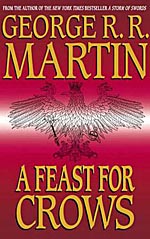
![]() MadProfessah
MadProfessah
12/28/2014
![]()
I have previously read and reviewed the first three books of the now-classic fantasy series, A Song of Ice and Fire, by George R.R. Martin, for this blog: A Game of Thrones, A Clash of Kings, and A Storm of Swords.
A Feast for Crows is considered by some the red-headed step child of the series so far because even though it is the most critically recognized entry in the series (nominated for the Hugo, Locus and British Fantasy Society awards although notably it failed to win any of these) it is also the book in the series which is rated the lowest by actual readers. There's a definite reason for this. A Feast for Crows was first published nearly 5 years after the publication of 2000's A Storm of Swords and the expectations of Martin's burgeoning fan base were extremely high. A Feast for Crows became the first book in the series to debut as #1 on the New York Times bestseller list and be an international publishing phenomenon. This is somewhat surprising, because several of the most popular characters from the series do not make an appearance in A Feast for Crows. Martin structures his novels as series of chapters with intersecting and overlayed points-of-views from specific characters on the same series of events. Because A Feast for Crows grew so gigantic during the five years Martin spent writing it, at some point he decided to concentrate on some of the less popular (some would say more villainous) characters in A Feast for Crows and push the perspectives of the more popular characters (Arya Stark, Tyrion Lannister, Jon Snow and Daenerys Targaryen to name a few) into the still-to-be-written A Dance with Dragons (which despite this headstart still took an agonizing 6 years to be published).
You'd think that the 4th entry in a series which has been decreed to be no longer than 7 books long would be concentrating on reducing the scope of the story not expanding it. If you thought that you'd be wrong, because Martin introduces several new characters who of course come with their own plots and allegiances which somehow link up to the previously revealed plots and allegiances like a slowly growing intricate spider-web or moss spreading inch by inch over a stone tomb.
The theme of the book is about power, and of course we all know absolute power corrupts absolutely. The anti-heroine of the series, Cersei Lannister Barratheon is know fully ascendant at the seat of power in King's Landing, although due to the inherent sexism (some would say misogyny) of the culture she is not officially crowned and of course does not sit on The Iron Throne, as her husband and sons have. Cersei is the kind of character readers love to hate and Martin puts her in her place somewhat, saving the coup de grace for the next book, we hope.
The plots are too numerous to summarize here, but suffice it to say that the conflict which has animated the first three books, the War of the Five Kings is quickly hurtling to a conclusion and this book is about what people do after the war is over, and how the "winners" and "losers" are both affected in its aftermath.
The one good thing about Martin pushing all the story lines of the favorite characters into A Dance with Dragons is that it makes that book an even more desirable read, and one that I will try to review shortly. Despite the slight lull that A Feast for Crows represents in the A Song of Ice and Fire series, it still points out how salient the stories and characters that Martin has created that even the secondary characters make for a compelling read, and promise that the next book should be even more so.
Title: A Feast for Crows
Author: George R. R. Martin
Length: 784 pages
Publisher: Bantam
Date: October 30, 2007
OVERALL GRADE: B/B-
PLOT: B-
IMAGERY: B
IMPACT: B+
WRITING: B-
http://buckmire.blogspot.com/2011/11/book-review-george-rr-martins-feast-for.html